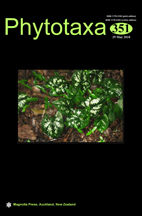Abstract
The genus Pohlia Hedwig is a large moss genus that has been placed in the Bryaceae family as traditionally determined. However, a molecular phylogenetic analysis has indicated that the Pohlia genus is more closely related to genera that are traditionally classified into the Mniaceae or Mielichhoferiaceae families. In this study, we performed a molecular phylogenetic analysis using evidence from four chloroplast regions (atpB-rbcL, rps4, trnG, and trnL-trnF) and one nuclear ribosomal intragenic spacer region (ITS) using different methods (maximum parsimony, maximum likelihood, and Bayesian inference). The phylogenetic relationships between Pohlia and its related genera are discussed.
Two large clades among our samples were well supported in all of the datasets. The traditionally defined Bryaceae species, including Brachymenium pendulum, Bryum caespiticium, Bryum capillare, Anomobryum gemmigerum, and Rhodobryum ontariense, formed a monophyletic clade with high support. The second clade corresponding to the Mielichhoferiaceae-Mniaceae complex also had high support. All of the Pohlia, Mielichhoferia and Mniaceae samples were included in this latter clade.
The clearest result from the phylogenetic analysis is that the Pohlia genus is non-monophyletic. The analysis is identical when using three methods and concludes that Pohlia is closer to the genera in Mielichhoferiaceae and Mniaceae. A formal taxonomic treatment of this clade was not performed because we lacked sufficient specimens of the species, although this work will be included in a future study.

